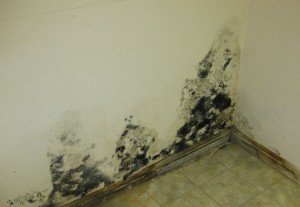Toxic black mould is often talked about these days. As government legislation mandates that all new homes be well insulated the occurrence of mould and other condensation related issues is increasing.
Stachybotrys chartarum, otherwise known a black mould (or mold) is a fungus that mainly grows on surfaces with high moisture content. It’s particularly prevalent in areas of high condensation such as bathrooms and kitchens. It may also occur in any area of high humidity. Often times people dry their washing on clothes horses and radiators in the living room, the evaporation
of condensation from the clothing and subsequent condensation onto surfaces can make for a breeding ground for black mould. It is especially prevalent on plasterboard and wallpaper.
This type of mould grows extremely slowly but can be quite hard to get rid of. Although black mould is perceived by many as toxic it does not always produce mycotoxins, mycotoxins are what are thought to cause associated ill health effects.
Mould and more specifically black mould has been as associated in recent years as a possible cause for chronic fatigue syndrome, otherwise known as ME. CFS sufferers often continually feel ill without any apparent cause. In a study published by The U.S National Center for Biotechnology Information, 93% of patients tested positive for mycotoxins.
In the documentary movie “Moldy”, biohacker Dave Asprey, sufferer of long term health effects due to mould, explores the various causes for mould in our environment and the effects it can have on humans. The people interviewed in the movie suffered from symptoms like rapid weight gain, memory loss, sore joints and breathing difficulties. While these are not common scientists think that some people may be genetically predisposed to mould allergies.
If your home has an infestation of black mould it is important that you deal with it. The important thing is to not agitate the mould by scrubbing or agitating the surface where it is present. This can cause spores to be released into the air where they can be more easily breathed in.
In fact it’s best not to tackle mould like this by yourself. Here at Fire Flood London we have extensive experience dealing with mould issues. We’ll use a special fungicidal PH plus solution to soak off slime moulds, reducing the amount of spores released into the surrounding environment.
After this process is wise to use a high-efficiency particulate air (HEPA) scrubber to completely remove any mould spores from the air inside the property. This not only improves the air quality but reduces chances of mould re-growing.
We may also use a HEPA vacuum carpets and soft furnishing where applicable.
We’ll also make recommendations on how you can prevent the mould returning, these are often inexpensive solutions and sometimes just simple advice that is easy to follow.
Although a cause for concern, any time of mould is treatable. If you’d like us to inspect your property and offer a solution with no obligation, get in touch today.


 020 8340 8338 or 07976 435 777
020 8340 8338 or 07976 435 777
 If you are unfortunate enough to experience fire or flood damage, call Fire and Flood, they take the stress out of the process and will have your place back to normal in no time.
If you are unfortunate enough to experience fire or flood damage, call Fire and Flood, they take the stress out of the process and will have your place back to normal in no time.